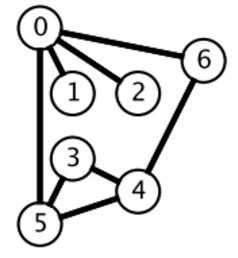Leetcode练习之搜索
深度优先搜索和广度优先搜索广泛运用于树和图中,但是它们的应用远远不止如此。
BFS
广度优先搜索一层一层地进行遍历,每层遍历都是以上一层遍历的结果作为起点,遍历一个距离能访问到的所有节点。需要注意的是,遍历过的节点不能再次被遍历。
第一层:
- 0 -> {6,2,1,5}
第二层:
- 6 -> {4}
- 2 -> {}
- 1 -> {}
- 5 -> {3}
第三层:
- 4 -> {}
- 3 -> {}
每一层遍历的节点都与根节点距离相同。设 di 表示第 i 个节点与根节点的距离,推导出一个结论:对于先遍历的节点 i 与后遍历的节点 j,有 di <= dj。利用这个结论,可以求解最短路径等 最优解 问题:第一次遍历到目的节点,其所经过的路径为最短路径。应该注意的是,使用 BFS 只能求解无权图的最短路径,无权图是指从一个节点到另一个节点的代价都记为 1。
在程序实现 BFS 时需要考虑以下问题:
- 队列:用来存储每一轮遍历得到的节点;
- 标记:对于遍历过的节点,应该将它标记,防止重复遍历。
1. 计算在网格中从原点到特定点的最短路径长度
1091. Shortest Path in Binary Matrix(Medium)
class Solution { public int shortestPathBinaryMatrix(int[][] grid) { if (grid == null || grid.length == 0 || grid[0].length == 0) { return -1; } int[][] direction = {{1,-1}, {1,0}, {1,1}, {0,-1}, {0,1}, {0,1}, {-1,-1}, {-1,0}, {-1,1}}; int m = grid.length; int n = grid[0].length; Queue<Pair<Integer, Integer>> queue = new LinkedList<>(); queue.add(new Pair<>(0, 0)); int pathLength = 0; while (!queue.isEmpty()) { int size = queue.size(); pathLength++; while (size-- > 0){ Pair<Integer, Integer> cur = queue.poll(); int cr = cur.getKey(); int cc = cur.getValue(); if (grid[cr][cc] == 1) { continue; } if (cr == m-1 && cc == n-1) { return pathLength; } grid[cr][cc] = 1; for (int[] d:direction) { int nr = cr + d[0]; int nc = cc + d[1]; if (nr < 0 || nr >= m || nc < 0 || nc >= n) { continue; } queue.add(new Pair<>(nr, nc)); } } } return -1; } }





【推荐】还在用 ECharts 开发大屏?试试这款永久免费的开源 BI 工具!
【推荐】国内首个AI IDE,深度理解中文开发场景,立即下载体验Trae
【推荐】编程新体验,更懂你的AI,立即体验豆包MarsCode编程助手
【推荐】轻量又高性能的 SSH 工具 IShell:AI 加持,快人一步